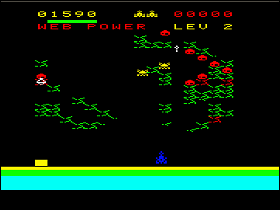 The Game: Spiders slink down from the top of the screen, constructing an elaborate web and laying eggs as they go. The player, manning a mobile bug-blasting cannon, can take out the spiders, but the eggs are still gestating and will hatch new spiders unless they’re destroyed; new spiders repeat the cycle in rapid succession. Spiders will manage to build their web to the bottom of the screen, restricting the cannon’s movement (and creating zones of the screen where future spider hatchlings can move unimpeded). The game ends when the player loses all of the cannons to the spiders or their incoming fire. (Emerson, 1982)
The Game: Spiders slink down from the top of the screen, constructing an elaborate web and laying eggs as they go. The player, manning a mobile bug-blasting cannon, can take out the spiders, but the eggs are still gestating and will hatch new spiders unless they’re destroyed; new spiders repeat the cycle in rapid succession. Spiders will manage to build their web to the bottom of the screen, restricting the cannon’s movement (and creating zones of the screen where future spider hatchlings can move unimpeded). The game ends when the player loses all of the cannons to the spiders or their incoming fire. (Emerson, 1982)
Memories: In this early epoch of the video game industry, there seemed to be a perception that you simply weren’t taking things seriously unless you secured an arcade license. Witness the Odyssey2, whose sole first-party licensed arcade port came too late in the machine’s library to bolster its popularity, or the Intellivision, which avoided arcade ports at first and then broke through to widespread popularity with a licensed home version of Burgertime.
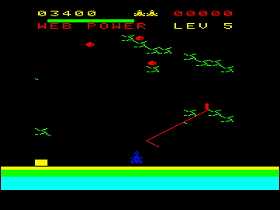 Not wanting to be a casualty of the video game wars, Emerson landed a handful of relatively obscure arcade licenses such as Jungler, Funky Fish and Spiders – none of them exactly household names in the coin-op world. (Most people probably can’t even remember seeing these games in the arcade at all; the author of this review barely remembers seeing Spiders and Jungler in the flesh.) Spiders was actually this vague and abstract in the arcade, too, so it’s really not a bad port, especially on the Arcadia 2001.
Not wanting to be a casualty of the video game wars, Emerson landed a handful of relatively obscure arcade licenses such as Jungler, Funky Fish and Spiders – none of them exactly household names in the coin-op world. (Most people probably can’t even remember seeing these games in the arcade at all; the author of this review barely remembers seeing Spiders and Jungler in the flesh.) Spiders was actually this vague and abstract in the arcade, too, so it’s really not a bad port, especially on the Arcadia 2001.
 For such an obscure arcade game, Spiders got around; there was also a fairly entertaining Entex tabletop game, though its matrix of fixed graphics made it much more difficult to figure out what was going on. The Arcadia version is fairly faithful to the original, duplicating the utter strangeness of the coin-op original nicely.[read more]
For such an obscure arcade game, Spiders got around; there was also a fairly entertaining Entex tabletop game, though its matrix of fixed graphics made it much more difficult to figure out what was going on. The Arcadia version is fairly faithful to the original, duplicating the utter strangeness of the coin-op original nicely.[read more]
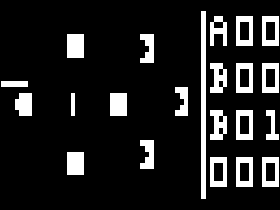 The Game: It’s a day at the digital ballpark for two players; the game is very simple – players control the timing of pitches and batting, which will determine how the game unfolds. The highest score at the end of nine innings wins. (RCA, 1977)
The Game: It’s a day at the digital ballpark for two players; the game is very simple – players control the timing of pitches and batting, which will determine how the game unfolds. The highest score at the end of nine innings wins. (RCA, 1977)
 The Game: Play ball! Two teams play until they each accumulate three “outs” per inning. Try to hit the ball out of the park, or confound the outfielders with a well-placed hit none of them can catch. Steal a base if you’re feeling really brave – and then try to cover your bases as best you can when the other player tries all of these same strategies on you. (Mattel Electronics, 1979)
The Game: Play ball! Two teams play until they each accumulate three “outs” per inning. Try to hit the ball out of the park, or confound the outfielders with a well-placed hit none of them can catch. Steal a base if you’re feeling really brave – and then try to cover your bases as best you can when the other player tries all of these same strategies on you. (Mattel Electronics, 1979)


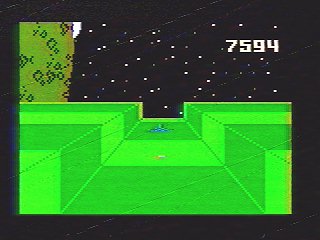

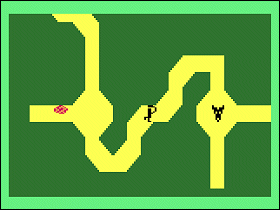 The Game: Your quest begins as you set out from the safety of home to look for adventure in mountainous caverns. When you wander into the dungeons and caverns, your view zooms in to the maze your adventurer is exploring, complete with treasures to collect and deadly dangers to duel. (Mattel Electronics, 1982)
The Game: Your quest begins as you set out from the safety of home to look for adventure in mountainous caverns. When you wander into the dungeons and caverns, your view zooms in to the maze your adventurer is exploring, complete with treasures to collect and deadly dangers to duel. (Mattel Electronics, 1982) The Game: You man three fixed artillery batteries defending the advanced underwater city of Atlantis. Alien spaceships pass overhead, and you have to choose your target – and which of the three guns you’re firing – carefully in order to knock them out. Any ships which survive one pass will drop down one level and make another pass. At the lowest level, the ships will begin bombing the city, knocking out habitation domes, power generators, and even your artillery nests. When the final destruction of Atlantis comes at last, one tiny ship escapes into the sky… (Imagic, 1982)
The Game: You man three fixed artillery batteries defending the advanced underwater city of Atlantis. Alien spaceships pass overhead, and you have to choose your target – and which of the three guns you’re firing – carefully in order to knock them out. Any ships which survive one pass will drop down one level and make another pass. At the lowest level, the ships will begin bombing the city, knocking out habitation domes, power generators, and even your artillery nests. When the final destruction of Atlantis comes at last, one tiny ship escapes into the sky… (Imagic, 1982)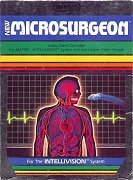 The Game: Ready for a fantastic journey? So long as you’re not counting on Raquel Welch riding shotgun with you, this is as close as you’re going to get. You control a tiny robot probe inside the body of a living, breathing human patient who has a lot of health problems. Tar deposits in the lungs, cholesterol clogging the arteries, and rogue infections traveling around messing everything up. And then there’s you – capable of administering targeted doses of ultrasonic sound, antibiotics and aspirin to fix things up. Keep an eye on your patient’s status at all times – and be careful not to wipe out disease-fighting white blood cells which occasionally regard your robot probe as a foreign body and attack it. Just because you don’t get to play doctor with the aforementioned Ms. Welch (ahem – get your mind out of the gutter!) doesn’t mean this won’t be a fun operation. (Imagic, 1982)
The Game: Ready for a fantastic journey? So long as you’re not counting on Raquel Welch riding shotgun with you, this is as close as you’re going to get. You control a tiny robot probe inside the body of a living, breathing human patient who has a lot of health problems. Tar deposits in the lungs, cholesterol clogging the arteries, and rogue infections traveling around messing everything up. And then there’s you – capable of administering targeted doses of ultrasonic sound, antibiotics and aspirin to fix things up. Keep an eye on your patient’s status at all times – and be careful not to wipe out disease-fighting white blood cells which occasionally regard your robot probe as a foreign body and attack it. Just because you don’t get to play doctor with the aforementioned Ms. Welch (ahem – get your mind out of the gutter!) doesn’t mean this won’t be a fun operation. (Imagic, 1982)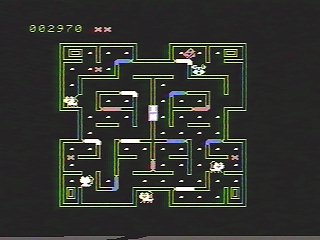 The Game: In this munching-maze game, you control a mouse who scurries around a cheese-filled maze which can only be navigated by strategically opening and closing yellow, red and blue doors with their color-coded buttons. Occasionally a big chunk o’ cheese can be gobbled for extra points. Is it that easy? No. There is also a herd of hungry kitties who would love a mousy morsel. But you’re not defenseless. By eating a bone, you can transform into a dog, capable of eating the cats. But each bone’s effects only last for a little while, after which you revert to a defenseless mouse. (Coleco, 1982)
The Game: In this munching-maze game, you control a mouse who scurries around a cheese-filled maze which can only be navigated by strategically opening and closing yellow, red and blue doors with their color-coded buttons. Occasionally a big chunk o’ cheese can be gobbled for extra points. Is it that easy? No. There is also a herd of hungry kitties who would love a mousy morsel. But you’re not defenseless. By eating a bone, you can transform into a dog, capable of eating the cats. But each bone’s effects only last for a little while, after which you revert to a defenseless mouse. (Coleco, 1982) The Game: Spiders slink down from the top of the screen, constructing an elaborate web and laying eggs as they go. The player, manning a mobile bug-blasting cannon, can take out the spiders, but the eggs are still gestating and will hatch new spiders unless they’re destroyed; new spiders repeat the cycle in rapid succession. Spiders will manage to build their web to the bottom of the screen, restricting the cannon’s movement (and creating zones of the screen where future spider hatchlings can move unimpeded). The game ends when the player loses all of the cannons to the spiders or their incoming fire. (Emerson, 1982)
The Game: Spiders slink down from the top of the screen, constructing an elaborate web and laying eggs as they go. The player, manning a mobile bug-blasting cannon, can take out the spiders, but the eggs are still gestating and will hatch new spiders unless they’re destroyed; new spiders repeat the cycle in rapid succession. Spiders will manage to build their web to the bottom of the screen, restricting the cannon’s movement (and creating zones of the screen where future spider hatchlings can move unimpeded). The game ends when the player loses all of the cannons to the spiders or their incoming fire. (Emerson, 1982) Not wanting to be a casualty of the video game wars, Emerson landed a handful of relatively obscure arcade licenses such as Jungler, Funky Fish and Spiders – none of them exactly household names in the coin-op world. (Most people probably can’t even remember seeing these games in the arcade at all; the author of this review barely remembers seeing Spiders and Jungler in the flesh.) Spiders was actually this vague and abstract in the arcade, too, so it’s really not a bad port, especially on the Arcadia 2001.
Not wanting to be a casualty of the video game wars, Emerson landed a handful of relatively obscure arcade licenses such as Jungler, Funky Fish and Spiders – none of them exactly household names in the coin-op world. (Most people probably can’t even remember seeing these games in the arcade at all; the author of this review barely remembers seeing Spiders and Jungler in the flesh.) Spiders was actually this vague and abstract in the arcade, too, so it’s really not a bad port, especially on the Arcadia 2001. For such an obscure arcade game, Spiders got around; there was also a fairly entertaining Entex tabletop game, though its matrix of fixed graphics made it much more difficult to figure out what was going on. The Arcadia version is fairly faithful to the original, duplicating the utter strangeness of the coin-op original nicely.[read more]
For such an obscure arcade game, Spiders got around; there was also a fairly entertaining Entex tabletop game, though its matrix of fixed graphics made it much more difficult to figure out what was going on. The Arcadia version is fairly faithful to the original, duplicating the utter strangeness of the coin-op original nicely.[read more]